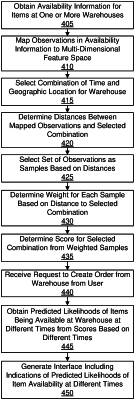| CPC G06Q 30/0205 (2013.01) [G06N 3/049 (2013.01); G06N 3/084 (2013.01); G06Q 30/0282 (2013.01); G06Q 30/0635 (2013.01); G06Q 30/0639 (2013.01); G06Q 30/0641 (2013.01)] | 21 Claims |

|
1. A method comprising:
obtaining availability information for one or more warehouses at an online concierge system, the availability information including one or more observations, with each observation comprising identifier of an item, an identifier of a warehouse, a label indicating whether the item was located at the warehouse, and contextual information;
mapping each observation to a multi-dimensional feature space based on the contextual information included in the observation, the multi-dimensional feature space having one or more dimensions based on temporal information and one or more dimensions based on geospatial information; and
for the warehouse, and each of a set of items and selected combinations of a time and a geographic location:
determining a distance between various mapped observations for the item of the set and selected combination of the time and the geographic location;
selecting a set of mapped observations as samples for the selected combination of the time and the geographic location based on the determined distances;
determining a weight for each sample, the weight for a sample based on a distance between the sample and the selected combination of the time and the geographic location;
determining a score for the warehouse, the item of the set, and the selected combination of the time and the geographic location based on the weighted samples; and
storing the score in association with the item of the set, the warehouse, and the selected combination of the time and the geographic location;
training a temporal availability model, wherein training of the temporal availability model comprises:
obtaining training data comprising a plurality of examples, each example including a training warehouse, a training item, a combination of training time and training geographic location, and a score determined for the training warehouse, the training item, and the combination of training time and training geographic location, a tag applied to each example indicating whether inventory of the training warehouse had the training item available for shoppers at the combination of the training time and the training geographic location;
initializing a plurality of layers of a neural network comprising the temporal availability model, where the temporal availability model is configured to receive the warehouse, the item, the combination of the time and the geographic distance, and the score associated with the item, the warehouse, and a combination of time and geographic location and to generate a predicted likelihood of the item being available at the warehouse at the combination of time and geographic location;
for each of a plurality of the examples of the training data:
applying the temporal availability model to the training warehouse, the training item, the combination of training time and training geographic location, and the score determined for the training warehouse, the training item, and the combination of training time and training geographic location,
backpropagating one or more error terms obtained from one or more loss functions to update a set of parameters of the temporal availability model, the backpropagating performed through the neural network and one or more of the error terms based on a difference between a tag applied to the example and a predicted likelihood of the training item being available at the training warehouse at the combination of the training time and the training geographic location; and
stopping the backpropagation after the one or more loss functions satisfy one or more criteria; and
for at least one item of set, applying the temporal availability model to determine a likelihood of the at least one item being available at the warehouse at the selected combination of the time and the geographic location.
|